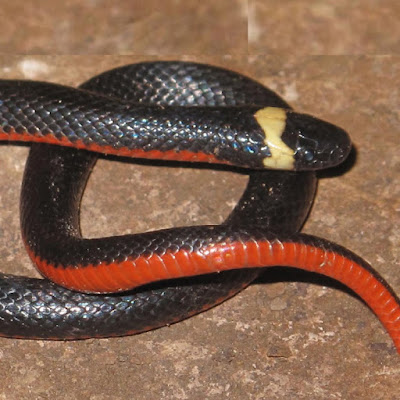[Most Recent Entries] [Calendar View]
Thursday, March 22nd, 2018
| Time | Event | ||
| 6:09a | [Herpetology • 2018] Taxonomic Review of the Rare Mexican Snake Genus Chersodromus (Serpentes: Dipsadidae), with the Description of Two New Species; Chersodromus australis & C. nigrum
Abstract Chersodromus is an endemic Mexican genus of snakes characterized by fused prefrontals shield. Only two species were previously known within the genus, C. liebmanni and C. rubriventris. We describe two new congeners, one from the Sierra Madre Oriental of northern Puebla and another from the Atlantic lowlands of the Chimalapas region in southeastern Oaxaca. These new species can be clearly differentiated on the basis of their morphology. Diagnostic characters distinguishing congeners include the number of dorsal scale rows, supralabials, and infralabials contacting anterior chinshields; whether or not the mental contacts the first pair of chinshields; and the coloration of the belly. We provide hemipenal descriptions of three species for which males are known. Keywords: Reptilia, external morphology, Hemipenis, Puebla, Chimalapas, Oaxaca Taxonomic account • Chersodromus liebmanni Reinhardt, 1860 • Chersodromus rubriventris (Taylor, 1949) • Chersodromus australis sp. nov. Etymology. The specific name is derived from the Latin australis, meaning southern, alluding to the southernmost distribution of species for the genus. • Chersodromus nigrum sp. nov. Etymology. The specific name is from Latin nigrum, meaning black, alluding at to the coloration of the dorsal and ventral surface. Luis Canseco-Márquez, Cynthia G. Ramírez-González and Jonathan A Campbell. 2018. Taxonomic Review of the Rare Mexican Snake Genus Chersodromus (Serpentes: Dipsadidae), with the Description of Two New Species. Zootaxa. 4399(2); 151–169. DOI: 10.11646/zootaxa.4399.2.1 facebook.com/HerpMX/photos/1717502394977043 facebook.com/groups/HerpMex/permalink/1782753821787271  Resumen: Chersodromus es un género endémico de México que se caracteriza por poseer las escamas prefrontales fusionadas. Solo dos especies eran previamente conocidas dentro del género, C. liebmanni y C. rubriventris. Describimos dos nuevas especies, una de la Sierra Madre Oriental del norte de Puebla y otra de las tierras bajas del Atlántico en la región de los Chimalapas, al sureste de Oaxaca. Estas nuevas especies se pueden diferenciar claramente con base en su morfología. Caracteres diagnósticos que las distinguen de sus congéneres son el número de escamas dorsales, supralabiales, e infralabiales en contacto con los escudos geniales anteriores; la mental puede o no estar en contacto con el primer par de escudos geniales; y la coloración del vientre. Proporcionamos descripciones de los hemipenes de tres especies de las cuales los machos son conocidos. Palabras clave: Morfología externa, Hemipenis, Puebla, Chimalapas, Oaxaca | ||
| 6:50a | [Herpetology • 2018] Squeezing Water from A Stone: High-throughput Sequencing from A 145-year Old Holotype Resolves (barely) A Cryptic Species Problem in Flying Lizards
Abstract We used Massively Parallel High-Throughput Sequencing to obtain genetic data from a 145-year old holotype specimen of the flying lizard, Draco cristatellus. Obtaining genetic data from this holotype was necessary to resolve an otherwise intractable taxonomic problem involving the status of this species relative to closely related sympatric Draco species that cannot otherwise be distinguished from one another on the basis of museum specimens. Initial analyses suggested that the DNA present in the holotype sample was so degraded as to be unusable for sequencing. However, we used a specialized extraction procedure developed for highly degraded ancient DNA samples and MiSeq shotgun sequencing to obtain just enough low-coverage mitochondrial DNA (547 base pairs) to conclusively resolve the species status of the holotype as well as a second known specimen of this species. The holotype was prepared before the advent of formalin-fixation and therefore was most likely originally fixed with ethanol and never exposed to formalin. Whereas conventional wisdom suggests that formalin-fixed samples should be the most challenging for DNA sequencing, we propose that evaporation during long-term alcohol storage and consequent water-exposure may subject older ethanol-fixed museum specimens to hydrolytic damage. If so, this may pose an even greater challenge for sequencing efforts involving historical samples. Conclusions: The development of HTS has revolutionized biological research by making genome-scale data readily available at a reasonable cost, even for non-model organisms. Systematists have fully embraced these advances in data acquisition for freshly sampled specimens, but are just beginning to harness HTS for the millions of fluid-preserved historical samples housed in natural history collections around the world. As we have shown here, acquiring genetic data from old museum specimens will sometimes present special challenges, but the information that can be gleaned from such specimens may be the only way to conclusively resolve previously intractable evolutionary and taxonomic questions. Jimmy A McGuire, Darko D Cotoras, Brendan O'Connell, Shobi Z S Lawalata, Cynthia Y Wang-Claypool, Alexander Stubbs, Xiaoting Huang, Guinevere O U Wogan, Sarah M Hykin, Sean B Reilly, Ke Bi, Awal Riyanto, Evy Arida, Lydia L Smith, Heather Milne, Jeffrey W Streicher and Djoko T Iskandar. 2018. Squeezing Water from A Stone: High-throughput Sequencing from A 145-year Old Holotype Resolves (barely) A Cryptic Species Problem in Flying Lizards. PeerJ. 6:e4470. DOI: 10.7717/peerj.4470 |
| << Previous Day |
2018/03/22 [Calendar] |
Next Day >> |






